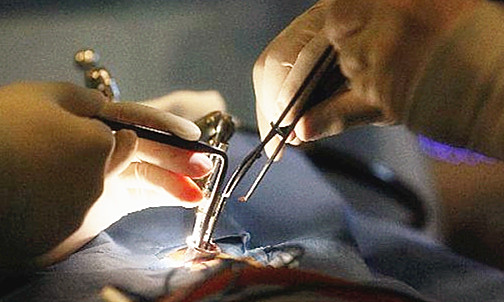New tech “lights up” nerves to identify, reduce accidental damage
August 21, 2017
Source: massdevice
 789
789

A new nerve-illuminating tool has been developed by researchers and they claim it makes nerves stand out from other tissue, lighting it up to help surgeons avoid accidentally injuring nerves and identify nerves in need of repair.
The tool, developed by Kenneth and Patrick Chin, uses an optical technique known as collimated polarized light imaging to help identify nerves during surgery. The system uses rotating polarization which is reflected off nerve tissue’s unique internal structure in a way that makes the reflection appear to switch on and off.
Results from a study of the device was published in the journal Biomedical Optics Express.
“We have shown that nerves can be distinguished in human tissue by detecting the interaction of light with the structure of nerves without the need for fluorescent markers or physical interaction. Using an intraoperative, noninvasive real-time method minimizes potential nerve damage, which can result in fewer negative consequences such as reduced function, loss of sensation or chronic pain,” CPLi designer Kenneth Chin of the Netherlands’ University of Amsterdam Academic Medical Center said in a prepared statement.
In the study, researchers used the CPLi technology to identify 13 tissue sides in the hand of a human cadaver. Investigators said that with the CPLi tech, surgeons were able to accurately identify nerves in the human hand 100% of the time, higher than the 77% reported accuracy rate for surgeons identifying nerves using only visual inspection.
In a separate experiment, researchers used CPLi to identify nerve tissue during a procedure to relieve pain in the wrist. Investigators said they plan to do additional tests of the technique during live surgery to better understand how the device works with a variety of patients and surgical conditions.
“We adapted the optics used for CPLi so that they could be incorporated in a surgical microscope, which can be placed above the surgical area. The resulting system can be used in a wide range of surgical fields where superficial nerves need to be identified,” Kenneth Chin said in prepared rmarks.
“This technique could improve the effectiveness of surgical interventions by helping the surgeon identify nerves in the operative field. This leads to surgeons being more confident in their surgical procedure, which will lead to less accidental injury and more targeted surgical interventions,” Thomas van Gulik of the Netherlands’ University of Amsterdam Academic Medical Center said in a press release.
By DduRead more on
- Things to Know before Buying Newborn Baby Incubators March 31, 2022
- Highly Resistant Food Poisoning Bug Responds to Antibiotics September 6, 2018
- Smartphone Based Diagnosis to Identify Mosquitoes Transmitting Infection September 5, 2018
- 3 Natural Plant Extracts Manufacturers on Drugdu.com September 4, 2018
- Shenzhen Chuanggan – Health Assessment Facility Supplier September 4, 2018
your submission has already been received.
OK
Subscribe
Please enter a valid Email address!
Submit
The most relevant industry news & insight will be sent to you every two weeks.



